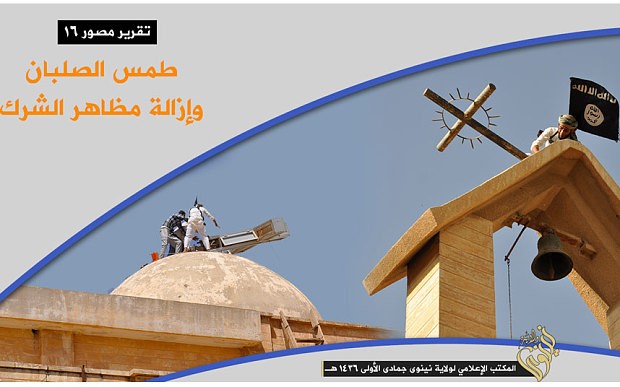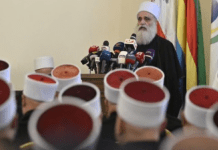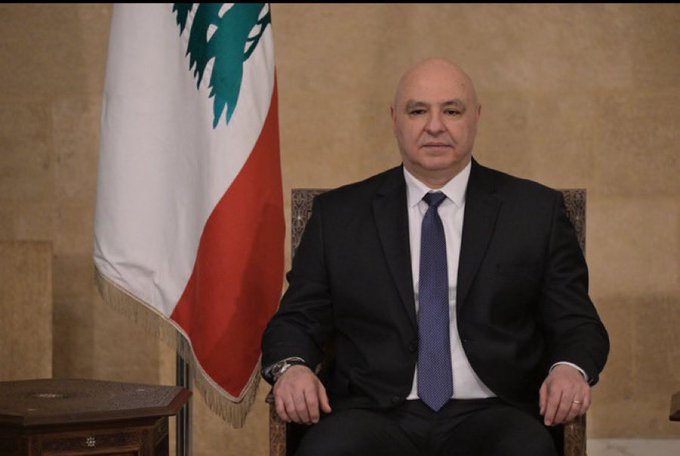The ISIS Caliphate and the Churches
Alberto M. Fernandez/MEMRI/August 27/15
Armenian Orthodox church in Raqqa, before and after ISIS takeover
The destruction by the entity known as the Islamic State (ISIS) in August 2015, of the over-1,500-year-old Syrian Catholic Monastery of Mar Elian, in Qaryatain, Syria – and of the even older ruins of the Temple of Ba’al Shameen at Palmyra – attracted worldwide condemnation and, as ISIS probably intended, considerable media attention.[1]
Churches, monasteries, and synagogues existed from the very first caliphate of Abu Bakr in 632 all the way through to the abolishment of the Ottoman caliphate in 1924. Sometimes favored, often persecuted, Christian communities existed and even flourished all throughout that period from the time of the Righteously Guided Caliphs[2] that ISIS claims to follow and revere.
The relationship between Salafi jihadists groups and local Christian populations has been a complicated one. While Al-Qaeda has always exhorted jihadis to keep their focus on their main enemy in the U.S., local groups have often targeted religious minorities. Some of the Egyptian jihadist groups of the 1970s which eventually became part of Al-Qaeda focused particularly on killing and robbing Coptic Christians, and gave justifications for doing so that were very similar to those that ISIS would later use.[3]
Still, as recently as September 2013, Al-Qaeda’s Al-Sahab Media issued a document titled “General Guidelines for Jihad,” in English, Arabic, and Urdu, which called for focusing on terrorism against the Crusader West but also for avoiding “meddling with Christian, Sikh and Hindu communities living in Muslim lands.”[4] Interestingly, it also called for avoiding “fighting the deviant sects such as Rawafidh [pejorative term for Shi’a], Ismailis, Qadianis, and deviant Sufis, except if they fight the Ahl Al-Sunnah.” Of course, these guidelines were often ignored by Al-Qaeda franchises, and by September 2013, Al-Qaeda and ISIS had broken off relations and gone their separate ways.
Islamic State “Abolishes” Pact of Omar
Al-Qaeda in Iraq and its successor the Islamic State of Iraq (ISI) directed most of their sectarian focus on the Shi’a; however, as early as March 2007, the State’s proto-caliph, “Commander of the Faithful” Abu Omar Al-Baghdadi (Hamid Al-Zawi) described Christians as fair game:
“We find that the sects of the People of the Book and others from the Sabians and so in the State of Islam today are people of war who qualify for no protection, for they have transgressed against whatever they agreed to in many countless ways, and if they want peace and security then they must start a new era with the State of Islam according to (Caliph) Omar’s stipulations [the historic “Covenant” of Caliph Omar with Christians] that they have annulled.”[5]
As Iraq scholar Nibras Kazimi has noted, this first Al-Baghdadi laid claim to authority based on the implementation of an aggressive Salafi agenda which claimed to have transformed Iraq, in 2007, into “one of the greatest nations on the face of the earth in maintaining monotheism, for there is no polytheistic Sufism being propagated, or shrines being visited, or innovated festivals being celebrated, or candles being lit, or a pilgrimage being made to a pagan totem, for the people of Iraq have destroyed these shrines with their own hands so that Allah will be worshiped alone.
“[6] Here then is the vividly illustrated Salafi agenda that ISIS would implement in Syria and Iraq as it took advantage of anarchy and dysfunction in large parts of both states.
Islamic State statements also blamed Arab Christians for promoting the concept of Arabism at the expense of Islam, an ironic charge given the claims about the role of Iraqi Baathists in the organization.[7] Arab nationalism is, of course, a principle tenet of Ba’athism. Some months after that announcement, gunmen killed Chaldean Catholic priest Ragheed Aziz Ghanni and three of his deacons in Mosul after they refused to either close their church or convert to Islam. In February 2008, the Chaldean Catholic Archbishop of Mosul Msgr. Paulos Faraj Rahho was kidnapped and killed by Islamic State gunmen.[8]
The general atmosphere of violence and insecurity in Iraq after the 2003 invasion meant that individual. Isis of all faiths were kidnapped and killed, sometimes for motives that seemed less than clear. But Iraqi Christian sites were targeted early on, with six churches in Baghdad and Mosul attacked with car bombs in August 2004.[9]
ISI suffered major personnel losses in April 2010, which led to Abu Bakr Al-Baghdadi (Ibrahim Al-Badri) taking over in May 2010. The new leader had an even more extensive Salafi pedigree than his predecessor, with an extended family with deep regional Salafi ties extending into Saudi Arabia’s own Salafi religious elite.[10]
Mourners march during a funeral for victims of an attack on the Our Lady of Salvation church in Baghdad, November 2, 2010/Thaier Al-Sudani.
On October 31, 2010, the Islamic State of Iraq launched its bloodiest, highest-profile attack on a Christian target to date, killing at least 50 worshippers during a Mass at the Syrian Catholic Cathedral of Sayyidat Al-Nejat (Our Lady of Salvation) in Baghdad. According to eyewitnesses, the gunmen made at least four claims for the killings, two general and two specific: all of the Christians were infidels; it is permitted to kill them; the killing was in retaliation for the burning of a Koran by an American pastor, and was also in retaliation for the alleged imprisonment of two supposed Muslim women converts in Egypt.[11]
The ISI statement issued a few days later by the Ansar Al-Mujahideen forum, in the name of ISI’s Al-Furqan Media Foundation, tied the attack, which may have been intended initially to be a hostage taking, not to the U.S. military presence in Iraq, nor even to the Koran burning – but to an Islamist-generated controversy involving two Coptic women in Egypt, Kamilia Shahada and Wafaa Constantine.[12] ISI promised death to Christians in Iraq, Egypt, and Syria and throughout the region in return for this perceived wrong. Why Iraqi Uniate Catholics should deserve death for the actions of Egyptian Coptic Orthodox – actions which did not result in death of anyone – is never explained.
In the Egyptian Islamist narrative, these two were women who left Christianity for Islam, and who were then forcibly handed back to the Coptic Orthodox Church and their Christian husbands. The fact that both women eventually made public statements noting that they had never converted to Islam and that they wished to remain Christians seemed immaterial to an Egyptian and regional Islamist blogosphere that bitterly thought otherwise.[13] The narrative feeds into a long-standing rich vein of anti-Coptic hysteria among Islamists, often involving women and sex, that has frequently led to violence in Egypt.[14] With advances in media outreach, such hatred has gone viral.
Raqqa and Mosul as Test Cases
The Islamic State of Iraq now went through of period of seeming eclipse and startling revival, which saw it gain strength through Iraq and eventually expand into Syria, taking the major city of Raqqa from other Syrian rebel factions and its rivals in Al-Qaeda’s Jabhat Al-Nusra (JN) in May 2013. Raqqa traditionally had a small Christian community and they had been cowed by the rebel presence. While churches had been closed, Nusra and company had essentially left the remaining Christians alone. This changed, with the much more rigorous ISIS (the “S” having been added in 2013) defacing churches and burning Bibles.[15] Long-term Syria resident Father Paolo Dall’Oglio, the Jesuit priest associated with Mar Musa al-Habashi Monastery in Eastern Homs, was also kidnapped in ISIS-ruled Raqqa and remains missing to this day.[16]
After burning Christian books, destroying churches, and kidnapping priests in Raqqa in 2013, ISIS then publicized, in February 2014, a new dhimmi pact with Christians in Raqqa State. The announcement received considerable attention in international media, but there is little evidence that there was much of a Christian community to form the pact with. Although the agreement includes the standard language of “not building a church, monastery or monk’s hermitage,” there is no evidence that any existing churches actually remained open or in Christian hands, much less that anyone would want to build any. Indeed, there are no images whatsoever of what could be described as normal Christian life in ISIS-controlled territory – no functioning churches, no monasteries or working priests, and no Christian families or Christian schools – all of which had existed throughout Islamic history.
The pact seems more aspirational, and more about preparing the stage for Abu Bakr al-Baghdadi’s assuming the mantle of the Caliph, which happened only four months later, than a real document regulating the life of an actual community.[17] Just as the Caliph Omar in the 7th century produced an agreement to regulate the life of a protected minority, so would the Caliph-in-Waiting do the same. The only thing missing were actual Christians.
The next milestone in ISIS-Christian relations is a well-known one: the extinction of the ancient Christian presence in the city of Mosul after its fall in June 2014. In what ISIS supporters would portray as an act of great mercy, the remaining Christian population was graciously allowed to depart with only the clothes on their backs, on July 19, 2014. Although Saudi ISIS cleric Abu Malik Anas Al-Nashwan would contrast the foolish actions of the Mosul Christians to the right choice of those of Raqqa, any reasonable observer would say that subsequent events have proved the Mosulis right. The extinguishing of Christian Mosul would be followed by an ISIS military advance in early August 2014 against the historic Christian villages of the Nineveh plain, with the entire population fleeing deeper into Kurdish-held territory.[18] As in Mosul and Raqqa, churches and Christian symbols in this area, some of them dating back to before the rise of Islam, were defaced or destroyed as representations of polytheism (shirk).
Improvising in Libya, Taking Hostages in Syria
The anarchy in still another Arab state, Libya, would give ISIS a new front for actions against Christians and, again, with justifications that seem to be only loosely tied to those usually drawn by ISIS Salafis from the formative period of Islam. Twenty-one hostages, 20 of them Coptic Christians, are beheaded on a Libyan beach in a highly orchestrated media production. As far as religious reasoning, there seemed to be none. It was done “in revenge for Kamilia and her sisters,” without explaining how killing 21 unconnected men is revenge for a woman who is still alive.[19]
The ISIS spokesman in the video also reminds viewers that “recently you’ve seen us on the hills of Al-Sham [Greater Syria] and on Dabeq’s Plain, chopping off the heads that had been carrying the cross delusion for a long time.” This would seem to be a reference to a series of much-publicized beheadings from August 2014 to January 2015, of three Americans, two Britons, and two Japanese, many of whom if not all, according to ISIS supporters, had converted to Islam in captivity. Certainly, none of these foreigners were presented as being beheaded because they had remained Christians and refused to convert to Islam.
Certainly ISIS has killed many Muslims, even beheaded them, but the Salafi justification for beheading Western captives who convert seems to be missing.[20] The standard narrative would be that if they converted, they would be seen as joining the ranks of Islam and their lives would have been spared. In terms of coverage, certainly, ISIS media is rife with Western converts to Islam and their stories. Middle East Christian captives who convert seem to be far rarer.[21] One could say that in the eyes of ISIS there are different types of “unbelief” and the rules, if there are any, that apply to some local Christians do not apply to some citizens of the “Crusader” countries.
An ISIS offensive in neighboring Syria added a new dimension to ISIS’s confessional relations, when some 230 Assyrian Christian civilians were taken hostage in late February 2015, when several of their villages on the Khabour River in Al-Hasakeh were overrun. Over the next six months, a handful of the hostages, all elderly or sick, were released in dribs and drabs. About 190 are still being held, many of them women and children. Given the ISIS propensity for media coverage, this particular issue has been surprisingly muted, being treated more like a traditional hostage-taking for money than another triumph of jihad.
The next ISIS action was very much a media operation intended to attract attention. On March 19, 2015, ISIS released images showing them blowing up the ancient Syrian Catholic Monastery of Mar Behnam, near Mosul. The destruction of Mar Behnam and, in August 2015, of Mar Elian Monastery in Syria show how ISIS glibly adjusts its rhetoric to suit its goals. Both monasteries were so old and established as to have been in place before the arrival of the first Muslims, which means that they had been spared by every Caliph who had ever ruled over these lands. Both monasteries had been in use. The Mar Behnam monks were expelled at gunpoint.[22] The two at Mar Elian were kidnapped in May 2015 and are still unaccounted for.[23]
The history of Islam’s interaction with Christian monks is a complex one, from the Koran on, but it is certainly not one of unrelieved hostility.[24] It would have been easy for ISIS to spare the monasteries and even the monks, thereby emulating traditions dating back to the Salaf and the Sahaba. But they chose to follow a more recent Salafi tradition, one especially put into practice by the Wahhabis of the late 18th and early 19th century, who zealously went about demolishing any semblance of shirk, such as the shrines of Sufi saints, or destroying the Islamic holy sites and indeed, many of the inhabitants, of the city of Kerbala.[25]
Sincerely Salafi But Looking for Clickbait
The next ISIS action involving Christians is perhaps the clearest demonstration of the essential nature of the organization: deeply and self-consciously Salafi in orientation but also ready to ruthlessly innovate for the sake of its own internal logic and for the sake of publicity. On April 19, 2015, ISIS released a video showing the killing of 30 Ethiopian Christians in Libya. While media outlets focused on the final two minutes which showed the killings, most of the video was a detailed exposition by a senior ISIS cleric, the Saudi Abu Malik Al-Tamimi, on how Christians are to be treated – jizya poll tax, conversion to Islam, or death – and the detailed rules for paying the jizya.[26] The video also fleetingly shows a handful of old men, supposedly in Raqqa, supposedly living as dhimmis, “protected” Christians who pay the jizya as part of a pact with the Islamic State.
The dissonance comes in with the killings at the end. Given the subject matter of most of the video and ISIS’s own internal logic, did the Ethiopians actually refuse to pay jizya? Wouldn’t they, as poor people, actually be exempt from paying, as traditionally women, children, slaves, the blind, the insane, monks and the destitute were exempt?[27] And why were they killed, except that they belong to the “hostile Ethiopian Church?” And given the historic practice of jizya, aren’t the ISIS actions themselves an abhorrent innovation (bid’ah) of the practice rather than a slavish Salafi following of early Islamic tradition?
The idea that ISIS are takfiri Salafi jihadists who are also making things up as they go along was underscored by their actions in an early August 2015 offensive in Eastern Homs, Syria. Overrunning the town of Al-Qaryatain, the organization seems to have taken hundreds of hostages with at least 60 Christians.[28] The Syrian Orthodox Archdiocese suggested the number of Christian hostages could be as high as 227.[29] In contrast to the very public expulsion and despoiling of the Mosul Christians, ISIS now seems to have decided, as in the case of the Khabour hostages, that there is value in holding on to these people as hostages and perhaps using them as bargaining chips or sources of income. Again, as in the case of the Khabour Christians, the ISIS media is surprisingly silent on the matter to date.
This overview of ISIS relations with local Christians from the time of the declaration of the Islamic State of Iraq to today shows a variety of public stances by the group. The specious justifications of ISI, the 2006-2010 Iraqi terrorist group, have given way to a more expansive vision, as the group truly became a terrorist “state.” ISIS is not the first entity to declare itself a Caliphate, but it seems to be the first Salafi Caliphate, and most of its actions fall within the scope of that worldview. This is why some of its actions – such as the destruction of churches and monasteries, and for that matter destroying surviving ruins from antiquity – make perfect sense within the Salafi context, even if they are actually not consistent with actual practice during the formative period of Islam.[30]
The same is true with the imposing of the jizya, which seems more a Salafi Caliphate publicity stunt than a careful recreation of jizya as practiced by the early Caliphs. There is no evidence of one open church or monastery in ISIS-controlled territory or of any sort of normal life by any religious minority within its boundaries. This reality underscores how similar the ISIS state is not to the sprawling pluralistic caliphates of history but to the monochrome, expansionist idol-breaking Emirate of Diriyah (1744-1818), the so-called first Saudi state, that was eventually destroyed by the Ottoman Empire and its surrogate in Khedival Egypt.
Any perceived differences from early Islam are examples of how ISIS “modifies its religious and political doctrines when they get in the way” of its principal aim which is establishing this “ultra-conservative Islamic state at all costs.”[31] The Al-Baghdadi Caliphate is reading from a Salafi manual drawn from early Islam, but is also busily writing emendations in the margins. So ISIS is many things, but is also a modern gloss on a Salafi interpretation of the formative period of Islam. As Edgar Allen Poe might say, it is a “dream within a dream.” For anyone not like them, it is a nightmare.
*Alberto M. Fernandez is Vice-President of MEMRI.
Endnotes:
[1] See MEMRI JTTM report ISIS Destroys Ancient Monastery In Homs, August 20, 2015.
[2] “Al-Rashidun,” the first four Caliphs – Abu Bakr, Omar, Othman, and Ali Ibn Abi Talib – who ruled from 632 to 661 A.D., the formative period of Islam after the death of Muhammad.
[3] Gilles Kepel, Muslim Extremism in Egypt, The Prophet and Pharaoh (Berkeley: University of California Press, 1986).
[4] Archive.org/details/JihadGuidelines, accessed August 27, 2015.
[5] Talismangate.blogspot.com/2007/03/al-baghdadis-third-speech-sounding.html, March 14, 2007.
[6] Talismangate.blogspot.com/2007/04/abu-omar-al-baghdadis-fourth-speech.html, April 17, 2007.
[7] Hudson.org/research/9854-the-caliphate-attempted-zarqawi-s-ideological-heirs-their-choice-for-a-caliph-and-the-collapse-of-their-self-styled-islamic-state-of-iraq, July 1, 2008.
[8] Reuters.com, May 18, 2008.
[9] CNN.com, August 1, 2004.
[10] Joshualandis.com/blog/meet-the-badris, March 13, 2015.
[11] Theguardian.com, November 1, 2010.
[12] Onlinejihad.files.wordpress.com/2010/11/isi.pdf.
[13] Nervana1.org/2015/02/16/isis-digs-out-old-grievances-to-attack-copts/ February 16, 2015.
[14] Alberto M. Fernandez, “In the Year of the Martyrs: Anti-Coptic Violence in Egypt, 1988-1993,” paper presented at the Middle East Studies Association Annual Meeting, San Francisco, California, November 18-20, 2001.
[15] Joshualandis.com/blog/al-qaedas-governance-strategy-raqqa-chris-looney, December 8, 2013.
[16] English.al-akhbar.com/node/20110, June 10, 2014.
[17]Joshualandis.com/blog/islamic-state-iraq-ash-shams-dhimmi-pact-christians-raqqa-province, February 26, 2014.
[18] BBC.com, August 7, 2014.
[19] Ahramonline, February 15, 2015.
[20] Nytimes.com, February 21, 2015. .
[21] MEMRI TV Clip No. 4842, ISIS Presents Conversion to Islam of Christian Captured in Syria, March 23, 2015.
[22] BBC.com, July 21, 2014.
[23] Christiantoday.com/article/syrian.monk.and.church.volunteer.kidnapped.from.monastery/54483.htm, May 22, 2015.
[24] Academia.edu/6728523/Christian_Monks_in_Islamic_Literature, Bulletin of the Royal Institute for Inter-Faith Studies
6, no. 2 (Autumn/Winter 2004).
[25]Ballandalus.wordpress.com/2014/08/02/the-wahhabi-sack-of-karbala-1802-a-d, August 2014.
[26] See MEMRI Special Dispatch No.5872, Senior Saudi Salafi Cleric: ‘ISIS Is A True Product Of Salafism’, November 4, 2014.
[27] The classic work is Abu Yusuf’s Kitab al-Kharaj. Abu Yusuf was chief Qadi under the Caliph Harun al-Rashid.
[28] Syriahr.com/en/2015/08/isis-seizes-syrian-christians-in-attempt-to-further-establish-stronghold-in-strategic-city, August 25, 2015,
[29] Facebook.com/DemandforAction/photos/pb.293404620839013.- 2207520000.1440515529./453479498164857/?type=3&theater.
[30] See MEMRI Special Dispatch No.5872, Senior Saudi Salafi Cleric: ‘ISIS Is A True Product Of Salafism’, November 4, 2014.
[31] Politico.com, August 19, 2015.






















